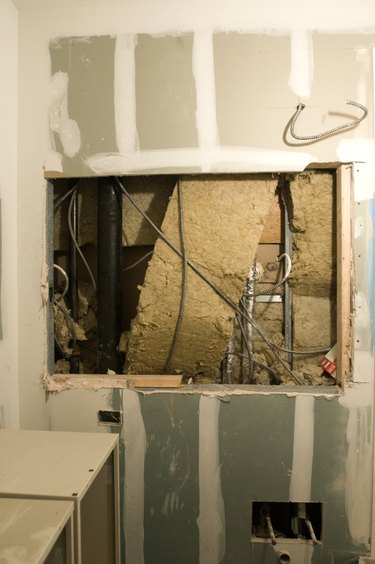
Many older buildings and homes have plaster walls, with a metallic mesh that serves as the framework. This metal can interfere with the high-frequency radio signal, known as wireless fidelity, or WiFi, that is transmitted from a router. This wire netting can block the wireless adapter in your laptop from getting a strong signal or maybe any signal at all. Replacing the plaster walling in a home is unfeasible in most situations, but you can try at least five remedies to get your WiFi signal through plaster walls. Some of these solutions are free, while others require a small investment.
Step 1
Move the router away from other metal objects that exacerbate interference from the plaster wall. If you have a metallic file cabinet, desk, entertainment center or any other large metal piece of furniture between the router and the plaster wall, it could reduce the strength of the wireless signal.
Video of the Day
Step 2
Change the wireless channel being broadcast by the router. The channel numbers are "1," "6" or "11." Look in your router's user manual to learn how to access the browser-based administration page, as well as the username and password. Other wireless devices in your home, such as a cordless phone, can interfere with the wireless Internet signal. Changing to a different channel might help your computer receive a better wireless signal through plaster walls.
Step 3
Obtain a high-gain antenna for your router. Many household routers broadcast a signal in all directions. Depending on the placement of your router and the position from which you use your laptop, the wireless adapter in your computer might receive only a fraction of the router's signal that transmits your Internet and network traffic.
Step 4
Convert from using an internal wireless adapter in a laptop to an external USB wireless adapter. If you carefully turn your laptop upside down, you might be able to see a square compartment or section labeled "Wireless LAN" or "WLAN" adapter. This usually indicates that your wireless adapter is right under that very spot, and this position under the laptop can reduce the strength of the signal through plaster walls.
Step 5
Install wireless powerline adapters. These networking devices plug into the electrical outlets in the wall. In one room, the router connects to the powerline adapter via an Ethernet cable. Internet traffic is then sent through the home's power system, through the plaster walls, to another powerline adapter in another room. This second powerline adapter has an antenna that wirelessly transmits data to the wireless adapter on your laptop. This method might completely eliminate the obstruction that the metal in the plaster wall poses to the wireless signal.
Video of the Day
- The Wall Street Journal: Culprit in Wi-Fi Failures -- Chicken Wires
- Microsoft: How to Improve Your Wireless Network and Boost Its Signal -- 10 Tips
- This Old House: Wi-Fi Versus Your Walls
- Microsoft: Windows 7 Compatibility for Networking
- Apple: Mac OS X, AirPort: Compatible Third-Party Wireless Cards